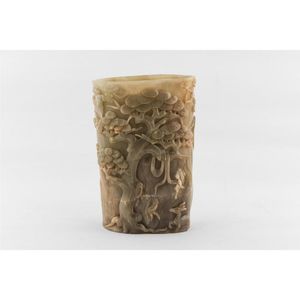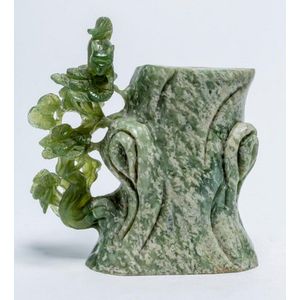
Ming Dynasty Chinese Mottled Jade Brush Pot, Black/Brown Pattern
A Chinese mottled black and brown jade brush pot, Ming Dynasty (1368-1644). 14 cm high, 8.5 cm diameter

Chinese Celadon Jade Brush Pot with Bamboo and Deer
A Chinese celadon jade brush pot carved all over with bamboo, prunus and cypress with a deer and crane, height 17 cm

Chinese carved jade amulet, brush pots, and engraved tablet collection
A Chinese carved jade amulet, pair of turned brush pots and an archaic style engraved tablet, (4 items), the largest 30 cm long

Chinese Jade Brush Pot: Storks in Flight Amongst Pine Trees
Large Chinese jade brush pot, of elliptical form, the exterior carved in relief with a scene of storks in flight amongst pine trees, sun and cloud scrolls, in tones of green, with Sotheby's label to base, height 11.5 cm and width 15 cm

Chinese Carved Green Jade Brush Pot with Floral Motifs
Fine Chinese carved green jade brush pot, of cylindrical form, carved continuously in slight relief with peonies, prunus and foliage, with incised archaic style script, mark to base, height 16 cm and diameter 11 cm

Carved Jade Brush Pot with Mountain Scene
Chinese carved jade brush pot, of handsome proportions, decorated with a carved continuous mountain scene, in tones of white and green, on wooden stand, height 9 cm (total)

Qianlong Jade Dragon Brush Pot
A pale-celadon jade 'dragon and cloud' brush pot, Qianlong four-character mark 16.1 cm high, 10.5 cm diam., 1320g

Carved Jade Brush Pot with Horseback Figure and Bamboo
Chinese carved jade brush pot, of cylindrical form, carved with a figure on horseback and scholar amongst bamboo, pine trees and mountains, in tones of white and brown, height 15 cm and diameter 12 cm

Tapered Chinese Brown Jade Brush Pot on Feet
Chinese brown jade brush pot, of tapered rectangular form, raised on four feet, height 15.5 cm

Qing Dynasty Jade Brush Pot with Dragon and Phoenix
Chinese late Qing Dynasty jade twin brush pot, carved with rampant dragon to one side and phoenix to the other, in tones of white and brown, the whole raised upon a wooden stand, 6.8 cm x 9.5 cm (object). Provenance: Dr. Merna Marie Torrington collection

Chinese Spinach Jade Dragon Brush Pot
Chinese spinach jade brush pot, of cylindrical form, decorated continuously with rampant dragons and flaming pearls, mark to base, height 16.5 cm. Provenance: Bonhams, Sydney 2011

Carved Jade Brush Pot with Figures and Landscape
Chinese carved jade brush pot, of cylindrical form, carved with a figure on horse back and scholar amongst bamboo, pine trees and mountains, in tones of white and brown, height 15 cm, diameter 12 cm

Celadon Jade Four Boys Brush Pot
A pale celadon jade four Boys brush pot, height 2.5 cm, diameter 9 cm

Green Jade Brush Pot with Prunus Blossom Decoration
A fine green jade brush pot, a fine and translucent cylindrical pot in rich deep green hues, continuously decorated in low relief with prunus blossom, bamboo and peony, with script to the body and a four character seal mark underside, height 17 cm

Chinese White Jade Brush Pot with Pine Branch Carvings
A Chinese white jade brush pot, of traditional straight sided form carved with a pine branch motif, height 15.5 cm

Chinese Jade Lotus Brushpot with Monkey and Vegetation
A Chinese jade double brushpot, the small pot in semi translucent celadon fashioned as a semi open lotus or bud with a monkey and vegetation to the sides. Height 3 cm. Length 9 cm. Width 7 cm

Jade Brushpot: Carved Cranes and Pine Trees
A jade brushpot featuring carved cranes and pine trees. Purchased Taylor's Chin Hua Galleries, Sydney 17 cm

Kangxi Marked Beehive Peach Bloom Brushpot with Silver Mounts
A beehive peach bloom brushpot Kangxi mark. A superb brushpot has been turned into an inkwell using silver and jade mounts (the jade most probably Ming dynasty), to the base a six-character Kangxi mark and possibly of the period. Height 10 cm

Jade Five Fortunes Brush Pot
Jade five Fortunes brush pot carved to show the five bats grouped together of the motif of the 'Five Good Fortunes.' These five good fortunes are wealth, health, longevity, love and virtue. Length 12.2 cm

Spinach-green Jade Brushpot with Dragon and Cloud Carvings
A large spinach-green jade brushpot of cylindrical form, the steep sides carved in relief on the exterior with seven writhing dragons pursuing flaming pearls on a dense ground of cloud scrolls, within raised bands at the base and rim, the slightly mottled…

Green Jade Brush Pot with Dragon Relief
A Chinese pale green jade brush pot, of oval shape with carved and pierced decoration and deep relief of hornless dragons amongst clouds. Length 8 cm

Contemporary Chinese Double Jade Brush Pot
A Chinese double jade brush pot, contemporary, the conjoined pots in a celadon shade embellished with carved and pierced foliate and branch decorations and with two exultant miniature figures clasping the edges. Height 3 cm. Width 10 cm. Depth 7 cm


 Loading more...
Loading more...